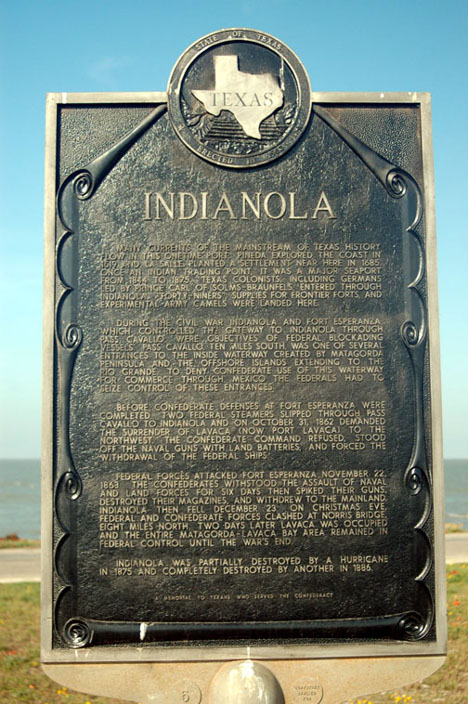

Indianola Historical Marker
Historical marker dedicated to the city of Indianola, Texas.
Located near the La Salle Monument on the western
shore of Matagorda Bay.
Marker Inscription
Many currents of the the mainstream of Texas history flow in this onetime port. Pineda explored the coast in 1519 and La Salle planted a settlement near here in 1685. Once an indian trading point it was a major seaport from 1844 to 1875. Texas colonists, including Germans led by Prince Carl of Solms-Braunfels entered through Indianola. "Forty-niners", supplies for frontier forts and experimental Army camels were landed here.
During the Civil War Indianola and Fort Esperanza which controlled the gateway to Indianola through Pass Cavallo were objectives of Federal blockading vessels. Pass Cavallo ten miles south was one of several entrances to the inside waterway created by Matagorda Peninsula and the offshore islands extending to the Rio Grande. To deny Confederate use of this waterway for commerce through Mexico the Federals had to seize control of these entrances.
Before Confederate defenses at Fort Esperanza were completed two Federal steamers slipped through Pass Cavallo to Indianola and on October 31, 1862 demanded the surrender of Lavaca (now Port Lavaca) to the northwest. the Confederate command refused , stood off the naval guns with land batteries and forced the withdrawal of the Federal ships.
Federal forces attacked Fort Esperanza November 22, 1863. the Confederates withstood the assault of naval and land forces for six days then spiked their guns, destroyed their magazines, and withdrew to the mainland. Indianola then fell December 23. On Christmas Eve Federal and Confederate forces clashed at Norris Bridge eight miles north. Two days later Lavaca was occupied and the entire Matagorda-Lavaca Bay area remained in Federal control until the war's end.
Indianola was partially destroyed by a hurricane in 1875 and completely destroyed by another in 1886.